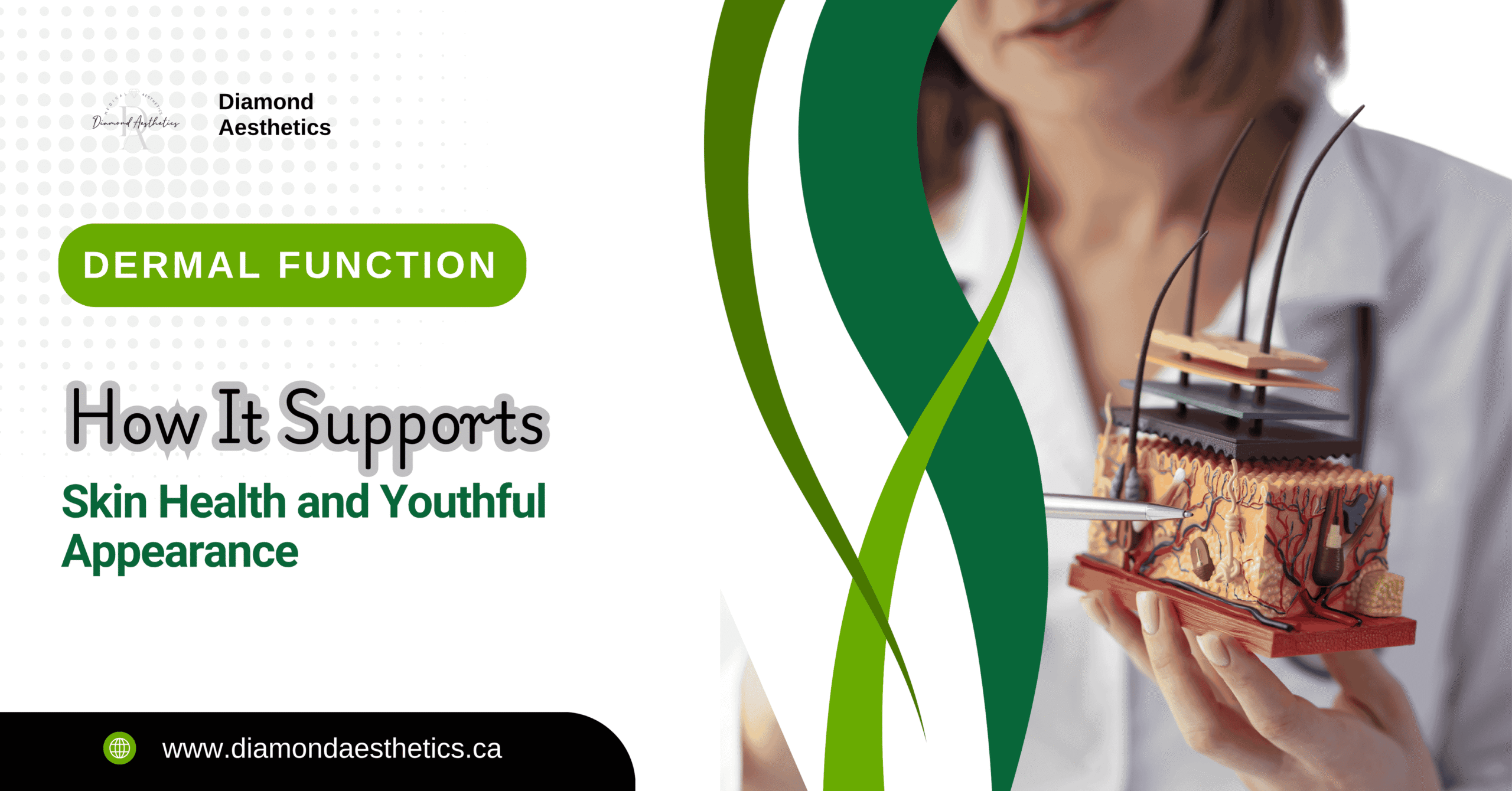Dermal function is essential to maintaining healthy skin, as it provides structural support, flexibility, and carries out several critical roles beneath the surface. As part of the skin, the largest organ in the body, it helps protect against external elements while sustaining and supporting the epidermis. This connective tissue layer absorbs physical stress, guards against irritants, and plays a key role in protecting your body from environmental harm. One of the most important aspects of dermal function is its ability to synthesize Vitamin D during sun exposure, which supports calcium absorption and overall wellness. By understanding how the dermis works, you can take better steps to protect your skin and keep it functioning at its best.
What Is the Dermis and Why Is It Important?
The dermis is the inner layer of the two main layers of the skin, located directly beneath the outer epidermis and above the deeper hypodermis. This connective tissue–rich and vascularized region plays a crucial role in supporting and protecting the skin as well as the deeper layers of the body.
Its primary roles include providing structural support and adding strength and pliability to the skin. The dermis is crucial for skin strength, elasticity, and the ability to sense the environment. It supports the epidermis by nourishing it and acts as a protective barrier, shielding your body from harm.
In addition to these functions, the dermis produces sweat, which helps regulate the body’s temperature, further contributing to overall skin health. Understanding these key roles sets the stage for a deeper exploration of how the dermis maintains skin vitality and resilience.
Dermal Function and Structure
The dermis provides structural support, elasticity, and sensation to the skin through a complex and fibrous framework. Your dermis contains collagen and elastin, which are essential for skin strength and flexibility. Key components of the dermis include:
- Collagen fibers: Make up about 70 percent of the dermis, providing firmness and structural support.
- Elastin fibers: Give the skin its elasticity, allowing it to stretch and return to shape.
- Blood vessels: Supply nutrients and oxygen while removing waste to maintain healthy skin.
- Lymphatic vessels: Assist in fluid drainage and immune defense.
- Sebaceous glands: Produce oil to keep the skin moisturized and protected.
- Sweat glands: Help regulate body temperature through sweat production.
- Nerves: Enable sensory reception for touch, pressure, and temperature sensations.
Together, these components form the fibrous and vascularized structure that supports the skin’s health, flexibility, and ability to respond to the environment.
Layers of the Dermis: Structure, Function, and Importance
The dermis is divided into two distinct layers: the papillary layer and the reticular layer. Each plays a specific role in maintaining skin function and structure.
Papillary Layer
- This is the superficial layer of the dermis, located just beneath the epidermis.
- It contains dermal papillae that extend into the epidermis, helping to strengthen the connection between the two layers.
- The papillary layer is the thinner of the two dermal layers and is rich in capillaries, lymph vessels, and sensory nerves, supporting nutrient exchange and touch sensitivity.
- It plays a crucial role in skin sensation and immune defense.
Reticular Layer
- The reticular layer, the deeper layer of the dermis, is thicker and denser than the papillary layer.
- It contains bundles of collagen fibers, which provide tensile strength and structural support to the skin.
- This layer houses sweat glands, sebaceous (oil) glands, hair follicles, blood vessels, nerves, and lymphatic vessels.
- The reticular dermis is essential for maintaining skin elasticity and resilience under physical stress.
Functional Differences
- The papillary layer supports the epidermis and is more involved in nutrient delivery, temperature regulation, and sensory perception.
- The reticular layer provides deeper structural integrity, anchoring accessory structures like glands and follicles while also protecting the body from mechanical stress.
Together, both layers of the dermis form an intricate system that supports the skin’s strength, function, and overall health.
Dermal Papillae: The Microstructures That Matter
Dermal papillae are small, specialized structures located at the base of hair follicles within the papillary layer of the dermis. Though microscopic, they play a powerful role in maintaining healthy skin and hair.
Key Functions of Dermal Papillae:
- Support for Hair Follicles:
Each dermal papilla (DP) is located at the bottom of the hair follicle and acts as a signaling center that regulates hair growth. It plays a key role in specifying the size, shape, and color of the hair, making it essential for both hair formation and individual hair characteristics. - Nutrient Exchange:
These microstructures facilitate the exchange of nutrients and oxygen between the dermis and epidermis. By supplying vital nourishment to surrounding cells, dermal papillae support skin regeneration and hair follicle vitality. - Skin Regeneration:
The dermal papilla plays an essential role in hair growth and skin renewal, contributing to wound healing and the skin’s natural repair processes. - Fingerprint Formation:
The unique patterns of dermal papillae contribute to your fingerprint patterns, which are formed where the papillae push into the epidermis and create ridges on the skin surface.
In summary, dermal papillae may be small, but their impact is significant, from driving hair development to supporting the regeneration and unique identity of your skin.
Dermal Function: How It Supports Epidermal Health and Hydration

The dermis and epidermis are closely connected through a thin yet vital layer known as the basement membrane. This membrane forms the structural bridge that allows the dermis to nourish and support the outer skin layer, ensuring overall skin health and resilience.
Key Functions:
- Nourishment and Structural Support:
The dermis provides essential nutrients and structural support to the epidermis. Its rich network of blood vessels supplies oxygen and nutrients to the lower layers of the epidermis, which itself lacks direct blood flow. - Hydration and Moisture Retention:
One of the most critical roles of the dermis is to help the skin retain 15%–20% of its water content. By maintaining proper hydration, the dermis keeps your body hydrated, supports elasticity, and strengthens the epidermis’s protective barrier. A well-hydrated dermis improves skin texture and prevents dryness or cracking. - Connection Through the Basement Membrane:
The basement membrane connects the dermis to the epidermis and ensures that both layers function in harmony. It helps maintain the skin’s layered structure while allowing the exchange of nutrients and signals needed for repair and renewal. - Support and Flexibility:
Your dermis’s structure provides strength and flexibility to the skin, ensuring that the epidermis remains supported even under physical stress, temperature changes, and environmental exposure.
In short, the dermal function in the epidermis is to nourish, hydrate, and structurally support the outermost skin layer—allowing it to protect the body and maintain a smooth, healthy appearance.
Epidermis Function vs. Dermal Function
| Feature | Epidermis | Dermis |
| Location | Outermost skin layer | Layer beneath the epidermis |
| Thickness | Thin, about 0.05 to 1.5 mm | Thicker, about 1 to 4 mm |
| Primary Function | Protective barrier | Structural support and elasticity |
| Components | Keratinocytes, melanocytes, Langerhans cells | Collagen, elastin fibers, blood vessels, nerve endings, sweat glands |
| Role | Protects against pathogens, UV damage, dehydration, and skin renewal | Provides strength, flexibility, sensation, and nutrient supply |
| Skin Tone | Melanin production | Does not produce melanin |
| Healing | Cell renewal and repair | Wound healing and scar formation |
Hypodermis Function and How It Complements the Dermis
The hypodermis, or subcutaneous layer, plays a crucial role in supporting overall dermal function by enhancing the skin’s ability to protect, insulate, and regulate. Positioned beneath the dermis, it helps stabilize and anchor the skin to underlying tissues, while contributing to the skin’s structure and resilience.
Key Functions of the Hypodermis:
- Fat Storage and Energy Regulation:
The hypodermis contains stored fat, which not only serves as a long-term energy reserve but also plays a role in aiding nutrient absorption. This energy storage helps sustain healthy dermal function, especially in times of stress or healing. - Insulation and Temperature Control:
Composed primarily of adipose tissue, the hypodermis provides insulation and cushioning, prevents heat loss, and helps regulate body temperature. This layer supports the skin’s protective barrier and works in harmony with the dermis to maintain thermal balance. - Shock Absorption and Support:
The fat in the hypodermis acts as a shock absorber, acting as a cushion to protect internal organs and muscles from mechanical stress. It also anchors the skin to deeper tissues, offering structural support that enhances overall dermal function.
By working together with the dermis, the hypodermis ensures that the skin not only looks healthy but also performs its essential protective and regulatory roles effectively.
Top 10 Functions of the Skin (Dermal and More)

The skin is the body’s largest organ, and its layers, especially the dermis, perform a wide range of essential functions. Below are the top 10 key roles your skin plays in maintaining overall health and protection:
- Protection
Acts as a physical barrier against environmental threats, including UV radiation, pollutants, pathogens, and physical injury. - Temperature Regulation
Controls body temperature through sweating, vasodilation, and vasoconstriction, with help from dermal blood vessels. - Sensory Reception
Contains nerve endings that detect touch, pressure, pain, and temperature, allowing you to respond to your environment. - Immune Defense
Hosts immune cells in the dermis that help detect and respond to harmful microbes or allergens before they penetrate deeper tissues. - Wound Healing
Initiates repair by forming clots, generating new cells, and using dermal structures to rebuild damaged tissue. - Vitamin D Synthesis
The skin helps synthesize vitamin D when exposed to sunlight, which aids in calcium absorption and promotes bone health. - Waste Excretion
Through sweat glands, the skin removes toxins and waste products such as urea, salts, and ammonia. - Moisture and Hydration Control
Helps the body retain water by preventing excessive moisture loss, supporting barrier integrity, and maintaining healthy skin texture. - Elasticity and Firmness
The dermis, rich in collagen and elastin, provides flexibility and strength, keeping the skin resilient and firm. - Microbial Barrier
Maintains a healthy microbiome and acidic pH that inhibits the growth of harmful bacteria and pathogens.
Skin Function: How the Epidermis, Dermis, and Hypodermis Work Together for Total Skin Health
This section gives a holistic view of how the three main layers of the skin coordinate to protect, regulate, and maintain the body’s overall health:
The skin is not just a surface barrier; it is a dynamic, multilayered organ where each layer, the epidermis, dermis, and hypodermis, plays a vital role. These layers function in harmony to ensure the skin can respond to environmental threats, physical injuries, and internal changes.
1. Epidermis – The First Line of Defense
The outermost layer, the epidermis, acts as a protective shield. It prevents pathogens, UV radiation, and harmful chemicals from penetrating the body. It also regulates moisture loss and is responsible for producing new skin cells and melanin, which gives skin its color.
2. Dermis – The Functional Powerhouse
Beneath the epidermis lies the dermis, which supports and nourishes the skin. It houses essential structures, including blood vessels, nerves, sweat glands, sebaceous glands, and hair follicles. The dermis plays a major role in:
- Sensory perception
- Temperature regulation
- Collagen and elastin production, which give skin firmness and elasticity
This layer is also central to dermal function, including wound healing and immune defense.
3. Hypodermis – Structural Support and Energy Storage
The hypodermis, or subcutaneous layer, connects the skin to muscles and bones. It contains adipose tissue that stores energy, cushions internal organs, and provides insulation.
This layer acts as a shock absorber, helps regulate body temperature, and supports nutrient transport.
Interlayer Coordination for Skin Health
- During an injury, epidermal cells regenerate while dermal blood vessels and immune cells manage healing and defense
- In cold temperatures, the hypodermis insulates the body, while the dermis adjusts blood flow to retain warmth
- In daily protection, all three layers work together to block toxins, fight microbes, and prevent dehydration
This synergy ensures the skin remains resilient, responsive, and capable of adapting to both internal and external factors, making it one of the most vital organs for overall health and protection.
FAQs About Dermal Function
What is the function of dermal?
The dermis supports skin structure, elasticity, blood flow, and sensation through collagen, elastin, and nerve endings.
What is the function of the dermal bone?
Dermal bone develops from connective tissue and is found in animals like fish. It’s not part of human skin anatomy.
What is an example of dermal tissue function?
During wound healing or sweating, the dermis regulates temperature and activates repair through collagen and blood flow.
Can the dermis regenerate itself?
Yes, it regenerates by producing collagen and fibroblasts. Treatments like microneedling help boost this process.
What happens when dermal function weakens?
It leads to wrinkles, dryness, and slower healing due to reduced collagen, circulation, and environmental stress.
How to Support and Protect Dermal Function
Maintaining healthy dermal function is essential for vibrant, youthful skin. Here are key ways to support and protect your skin’s dermis:
Sun Protection
Use broad-spectrum sunscreen with adequate SPF daily to prevent ultraviolet damage, which can degrade collagen and accelerate aging.
Hydration
Drink plenty of water and apply moisturizers regularly to keep the skin hydrated and maintain its barrier function.
Nutrition
Incorporate vitamins C, A, and E, along with omega-3 fatty acids, into your diet. These nutrients support collagen synthesis and protect against oxidative stress.
Skincare
Use products containing retinoids and antioxidants to stimulate cell renewal and combat free radicals. Gentle exfoliation helps remove dead skin cells and promotes healthy skin turnover.
Professional Treatments
Consider advanced therapies such as laser treatments, microneedling, and collagen stimulation procedures to enhance dermal repair and rejuvenation.
Lifestyle Tips
Avoid smoking, manage stress effectively, and ensure sufficient sleep. These factors play a crucial role in maintaining skin health and supporting its natural regenerative processes.
Conclusion: Why You Should Care About Dermal Function
A healthy dermal function is key to strong, youthful skin. It supports elasticity, texture, and natural repair, helping to prevent aging signs. At Diamond Aesthetics, we offer advanced treatments like dermal fillers, microneedling, and laser therapy to restore and enhance your skin’s dermal function.
Combining expert care with personalized advice, we help you maintain radiant, healthy skin. To learn more or book a consultation, visit Diamond Aesthetics, your destination for the best dermal function treatments.





Venture into the vast sandbox of EVE Online. Forge your empire today. Create alongside hundreds of thousands of pilots worldwide. [url=https://www.eveonline.com/signup?invc=46758c20-63e3-4816-aa0e-f91cff26ade4]Join now[/url]